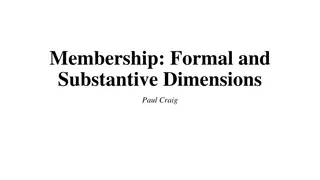Understanding Dimensions and Units in Describing Physical Properties
A moving object can be described in terms of various measurable properties such as mass, length, area, volume, velocity, acceleration, temperature, and more. These dimensions play a crucial role in dimensional reasoning and forming accurate physical equations. The SI system provides a rationalized set of metric units from fundamental dimensions like length, mass, time, electric current, absolute temperature, and luminous intensity.
Download Presentation

Please find below an Image/Link to download the presentation.
The content on the website is provided AS IS for your information and personal use only. It may not be sold, licensed, or shared on other websites without obtaining consent from the author. Download presentation by click this link. If you encounter any issues during the download, it is possible that the publisher has removed the file from their server.
E N D
Presentation Transcript
EXAMPLE: A moving object could be described in terms of its; Mass Length Area Volume Velocity Acceleration It s Temperature or electrical properties, density, viscosity of the medium through which it moves would also be of importance, since they would affect its motion. These MEASURABLE properties used to describe PHYSICAL STATE of the body or systems are known as its DIMENSIONS. UNITS: To complete the description of the physical situation, it is also necessary to know the MAGNITUDE dimension. Length=(meter). The distinction between dimensions is that properties that can be measured and units are standard elements in terms of which these dimensions can be described quantitatively and assigned numerical values of each units and are dimensions
DIMENSIONAL REASONING: Analyzing any physical situation it is necessary to decide what factors are involved; Then try to determine a quantitative relationship between them. The factors involved can be assessed from OBSERVATION, EXPERIMENT or INTUITION. 1+3=4 numerically correct but in physical terms it may be untrue, for example 1elephant + 3 aero planes =4 days is untrue. An equation describing a physical situation will only be true if all the terms are of the same kind and have the same dimensions. Area = LxL=L2 area has the dimension of L2 . The corresponding unit of area will be the unit of length squared m2 in SI units. L = = 1 V LT T 1 V LT = = = 2 a LT T T In practice for any given system of units, the constant of proportionality is made UNITY. Force Force = Mass x Acceleration Mass x Acceleration
= F ma = 2 F MLT Force F = = = 2 Pr essure FL 2 Area L Mass M = = = 3 Density SEE PAGE 669 DOUGLAS FOR DIMENSIONS OF QUANTITIES COMMONLY OCCURING IN MECHANICS TABLE 24.1. The SI system is a rationalized system of metric units in which the units for all physical quantities can be derived from SIX Length meter ML 3 Volume L = 2 1 M FT L = = 3 2 4 Density Mass kilogram Time second Electric current ampere Absolute temperature kelvin Luminous Intensity candela Details of the basic and derived SI units are given in Table 24.3 page 673 (Douglas) ML FT L























